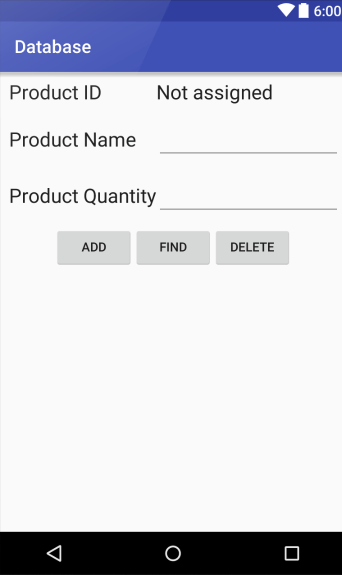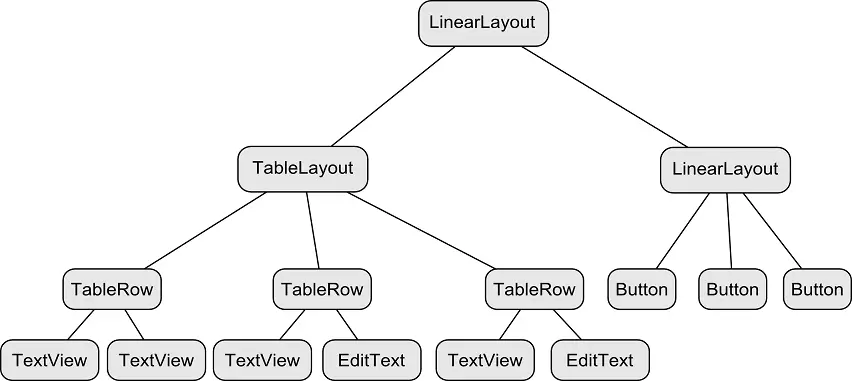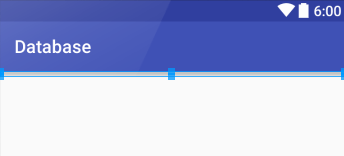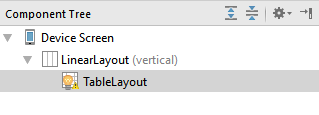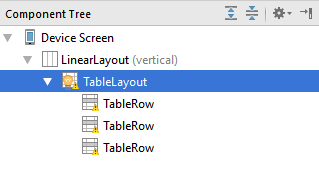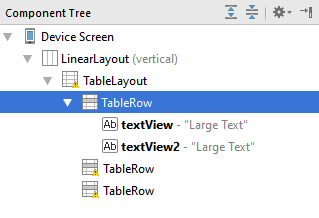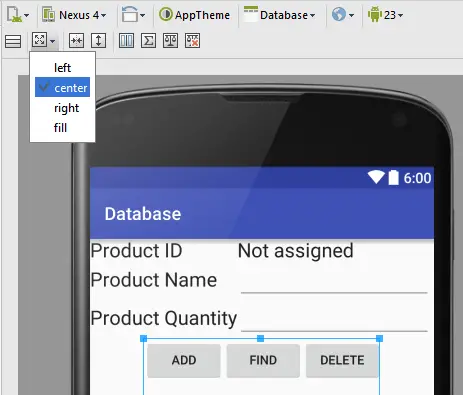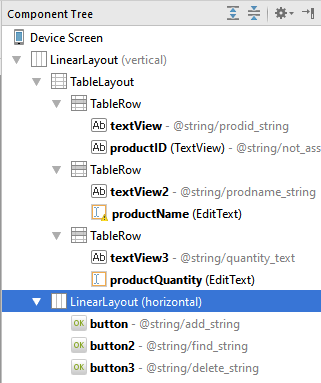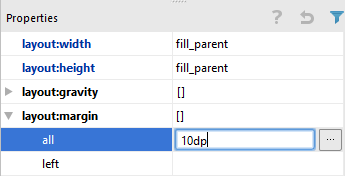An Android 6 TableLayout and TableRow Tutorial
| Previous | Table of Contents | Next |
| An Overview of Android 6 SQLite Databases | An Android 6 SQLite Database Tutorial |
When the work began on the next chapter of this book (An Android SQLite Database Tutorial ) it was originally intended that it would include the steps to design the user interface layout for the database example application. It quickly became evident, however, that the best way to implement the user interface was to make use of the Android TableLayout and TableRow views and that this topic area deserved a self-contained chapter. As a result, this chapter will focus solely on the user interface design of the database application completed in the next chapter, and in doing so, take some time to introduce the basic concepts of table layouts in Android Studio.
The TableLayout and TableRow Layout Views
The purpose of the TableLayout container view is to allow user interface elements to be organized on the screen in a table format consisting of rows and columns. Each row within a TableLayout is occupied by a TableRow instance, which, in turn, is divided into cells, with each cell containing a single child view (which may itself be a container with multiple view children).
The number of columns in a table is dictated by the row with the most columns and, by default, the width of each column is defined by the widest cell in that column. Columns may be configured to be shrinkable or stretchable (or both) such that they change in size relative to the parent TableLayout. In addition, a single cell may be configured to span multiple columns.
Consider the user interface layout shown in Figure 47-1:
Figure 47-1
From the visual appearance of the layout, it is difficult to identify the TableLayout structure used to design the interface. The hierarchical tree illustrated in Figure 47-2, however, makes the structure a little easier to understand:
Figure 47-2
Clearly, the layout consists of a parent LinearLayout view with TableLayout and LinearLayout children. The TableLayout contains three TableRow children representing three rows in the table. The TableRows contain two child views, with each child representing the contents of a column cell. The LinearLayout child view contains three Button children.
The layout shown in Figure 47 2 is the exact layout that is required for the database example that will be completed in the next chapter. The remainder of this chapter, therefore, will be used to work step by step through the design of this user interface using the Android Studio Designer tool.
Creating the Database Project
Start Android Studio and create a new project, entering Database into the Application name field and ebookfrenzy.com as the Company Domain setting before clicking on the Next button. On the form factors screen, enable the Phone and Tablet option and set the minimum SDK setting to API 8: Android 2.2 (Froyo). Continue to proceed through the screens, requesting the creation of an empty activity named DatabaseActivity with a corresponding layout file named activity_database.
Adding the TableLayout to the User Interface
Locate the activity_database.xml file in the Project tool window (app -> res -> layout) and double click on it to load it into the Designer tool. By default, Android Studio has used a RelativeLayout as the root layout element in the user interface. This needs to be replaced by a vertically oriented LinearLayout. With the Designer tool in Text mode, replace the XML with the following:
<?xml version="1.0" encoding="utf-8"?>
<LinearLayout
android:orientation="vertical"
android:layout_width="match_parent"
android:layout_height="match_parent"
xmlns:android="http://schemas.android.com/apk/res/android">
</LinearLayout>
Switch to Design mode and, referring to the Layouts section of the Palette, drag and drop a TableLayout view so that it is positioned at the top of the LinearLayout canvas area as illustrated in Figure 47-3:
Figure 47-3
Once these initial steps are complete, the Component Tree for the layout should resemble that shown in Figure 47-4:
Figure 47-4
Adding and Configuring the TableRows
Figure 47-5
From within the Widgets section of the palette, drag and drop two Large Text TextView objects onto the uppermost TableRow entry in the Component Tree (Figure 47-6):
Figure 47-6
Double click on the left most TextView within the screen layout and, in the quick property settings panel, change the text property to “Product ID”. Repeat this step for the right most TextView, this time changing the text to “Not assigned” and specifying an id value of productID. Extract the text for each TextView to new string resources using the light bulb icon displayed when the view is selected.
Drag and drop another Large Text view and a Plain Text Edit Text view from the Text Fields section of the palette onto the second TableRow entry in the Component Tree. Change the text on the TextView to Product Name and the ID of the EditText object to productName.
Drag and drop another Large Text view and a Number (Decimal) Text Field onto the third TableRow. Change the text on the TextView to Product Quantity and the ID of the Text Field object to productQuantity. Before proceeding, be sure to extract all of the text properties added in the above steps to string resources.
Adding the Button Bar to the Layout
The next step is to add a LinearLayout (Horizontal) view to the parent LinearLayout view, positioned immediately below the TableLayout view. Drag and drop a LinearLayout (Horizontal) instance from the Layouts section of the Designer palette and drop it directly onto the LinearLayout (Vertical) entry in the Component Tree panel.
Drag and drop three Button objects onto the new LinearLayout and assign string resources for each button that read “Add”, “Find” and “Delete” respectively.
With the new horizontal Linear Layout view selected in the Component Tree, click on the Gravity button in the Designer toolbar (Figure 47-7) and select the Center gravity option so that the buttons are centered horizontally within the display:
Figure 47-7
Figure 47-8
Adjusting the Layout Margins
All that remains is to adjust some of the layout settings. Begin by clicking on the first TableRow entry in the Component Tree panel so that it is selected. Hold down the Ctrl-key on the keyboard and click in the second and third TableRows so that all three items are selected. In the Properties panel, locate the layout:margin property category and, once located, unfold the category and change the all setting to 10dp as shown in Figure 47-9:
Figure 47-9
With margins set on all four sides of the three TableRows, the user interface should appear as illustrated in Figure 47-1. For the sake of completeness, and for comparison purposes in the event that your layout does not match that in Figure 47-1, the full activity_database.xml structure for this layout is outlined below.
<?xml version="1.0" encoding="utf-8"?>
<LinearLayout
android:orientation="vertical"
android:layout_width="match_parent"
android:layout_height="match_parent"
xmlns:android="http://schemas.android.com/apk/res/android">
<TableLayout
android:layout_width="match_parent"
android:layout_height="wrap_content"
android:layout_gravity="center_horizontal">
<TableRow
android:layout_width="match_parent"
android:layout_height="match_parent"
android:layout_margin="10dp">
<TextView
android:layout_width="wrap_content"
android:layout_height="wrap_content"
android:textAppearance="?android:attr/textAppearanceLarge"
android:text="@string/prodid_string"
android:id="@+id/textView" />
<TextView
android:layout_width="wrap_content"
android:layout_height="wrap_content"
android:textAppearance="?android:attr/textAppearanceLarge"
android:text="@string/not_assigned_string"
android:id="@+id/productID" />
</TableRow>
<TableRow
android:layout_width="match_parent"
android:layout_height="match_parent"
android:layout_margin="10dp">
<TextView
android:layout_width="wrap_content"
android:layout_height="wrap_content"
android:textAppearance="?android:attr/textAppearanceLarge"
android:text="@string/prodname_string"
android:id="@+id/textView2" />
<EditText
android:layout_width="wrap_content"
android:layout_height="wrap_content"
android:id="@+id/productName" />
</TableRow>
<TableRow
android:layout_width="match_parent"
android:layout_height="match_parent"
android:layout_margin="10dp">
<TextView
android:layout_width="wrap_content"
android:layout_height="wrap_content"
android:textAppearance="?android:attr/textAppearanceLarge"
android:text="@string/quantity_text"
android:id="@+id/textView3" />
<EditText
android:layout_width="wrap_content"
android:layout_height="wrap_content"
android:inputType="number"
android:ems="10"
android:id="@+id/productQuantity" />
</TableRow>
</TableLayout>
<LinearLayout
android:orientation="horizontal"
android:layout_width="wrap_content"
android:layout_height="match_parent"
android:layout_gravity="center_horizontal">
<Button
android:layout_width="wrap_content"
android:layout_height="wrap_content"
android:text="@string/add_string"
android:id="@+id/button" />
<Button
android:layout_width="wrap_content"
android:layout_height="wrap_content"
android:text="@string/find_string"
android:id="@+id/button2" />
<Button
android:layout_width="wrap_content"
android:layout_height="wrap_content"
android:text="@string/delete_string"
android:id="@+id/button3" />
</LinearLayout>
</LinearLayout>
Summary
The Android TableLayout container view provides a way to arrange view components in a row and column configuration. While the TableLayout view provides the overall container, each row, and the cells contained therein, are implemented via instances of the TableRow view. In this chapter, a user interface has been designed in Android Studio using the TableLayout and TableRow containers. The next chapter will add the functionality behind this user interface to implement the SQLite database capabilities.
| Previous | Table of Contents | Next |
| An Overview of Android 6 SQLite Databases | An Android 6 SQLite Database Tutorial |




